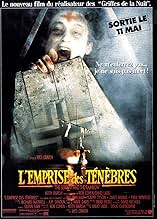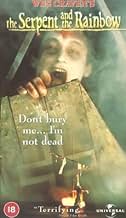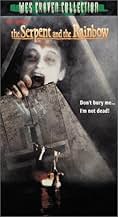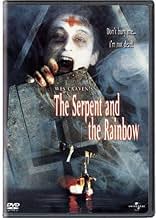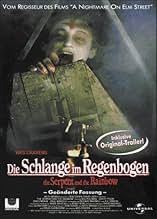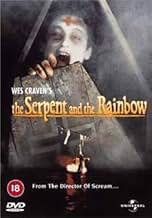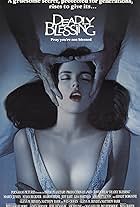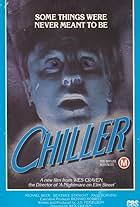An anthropologist goes to Haiti to research a drug that makes someone appear dead by suspending all vital signs.An anthropologist goes to Haiti to research a drug that makes someone appear dead by suspending all vital signs.An anthropologist goes to Haiti to research a drug that makes someone appear dead by suspending all vital signs.
- Director
- Writers
- Stars
- Awards
- 1 nomination total
Jaime Pina
- Julio
- (as Jaime Piña Gautier)
Kimberleigh Aarn
- Margrite
- (as Kimberleigh Burroughs)
- Director
- Writers
- All cast & crew
- Production, box office & more at IMDbPro
Featured reviews
Wes Craven's "The Serpent and the Rainbow" is one of the more original and ambitious horror movies to come out of the '80s. Not only does it seek to reconnect cinematic zombies with their voodoo roots, ala classics like "White Zombie", but it also uses the creation of zombies as a political allegory. The film is set in Haiti during the last days of the dictatorship of "Baby Doc" Duvalier.
Based - very loosely one surmises - on a true story, the plot follows Dr. Dennis Alan (Bill Pullman) as he investigates a powder that is said to turn people into zombies. He is aided in his quest by Dr. Marielle Duchamp (Cathy Tyson), who he quickly falls for, and Louie Mozart (Brent Jennings) an expert in voodoo. Dargent Peytraud (the chilling Zakes Mokae) is the snarling villain of the piece, a man with sinister powers both government-sanctioned and supernatural.
The film abounds with creatively gruesome imagery - a man is buried alive, screaming, in a coffin as it fills with blood, a fiendish hand reaches out from a bowl of soup - this is one of those rare films that genuinely makes your skin crawl. Horror fans should not miss it. It's a shame that the film runs just a little longer than it should and becomes disappointingly routine in its final moments.
There is a sense that this movie was aiming a bit higher than it ending up reaching. I can't quite hold that against it.
Based - very loosely one surmises - on a true story, the plot follows Dr. Dennis Alan (Bill Pullman) as he investigates a powder that is said to turn people into zombies. He is aided in his quest by Dr. Marielle Duchamp (Cathy Tyson), who he quickly falls for, and Louie Mozart (Brent Jennings) an expert in voodoo. Dargent Peytraud (the chilling Zakes Mokae) is the snarling villain of the piece, a man with sinister powers both government-sanctioned and supernatural.
The film abounds with creatively gruesome imagery - a man is buried alive, screaming, in a coffin as it fills with blood, a fiendish hand reaches out from a bowl of soup - this is one of those rare films that genuinely makes your skin crawl. Horror fans should not miss it. It's a shame that the film runs just a little longer than it should and becomes disappointingly routine in its final moments.
There is a sense that this movie was aiming a bit higher than it ending up reaching. I can't quite hold that against it.
Bill Pullman is an anthropologist who on a previous visit to Haiti experienced the power of black voodoo,filling his mind with evil dreams and eventuating in the murder of his pilot. His Jaguar spirit leads him to safety. Upon returning to America he is asked by a drug company to return to Haiti and investigate the process of "Zombification" as proof of a man being brought back from the dead has been discovered and the Americans of course would love to know how it is done.
In Haiti Dr Allen meets a beautiful female psychiatrist and together they become embroiled in a world of good vs evil voodoo style in search of this miracle which is in the form of a powder.
However, their is evil at work in the form of a very nasty voodoo witchdoctor, who unfortunately also happens to be Chief of Police in the very much oppressed Haiti.
This was a great film. I only just purchased and watched it for the first time on DVD for $6.95 AU, at that price I wasn't expecting much - Reviews I have read regarding this film dubbed it dissapointing, but I found it to be highly entertaining.
The film is eerie, the acting is excellent. I have found in most reviews that people have complained that the film is far-fetched and doesn't make sense. Well, in my opinion - that is the nature of voodoo -it is un-explainable and to a skeptical mind is silly, but there have been many accounts in real life of voodoo magic and it's power and this film was based on some such accounts.
The film starts of a little slow and can be described as a bit messy. However, as the plot unfolds, not only are we watching an eerie film about the supernatural, we are also watching an action packed political thriller. This is a very unusual film. There is just enough blood and gore to entertain the slasher fans, but not too much discourage the general film appreciating public.
As opposed to common belief, I found the story-line of this film to be tight, different and utterly engaging.
In Haiti Dr Allen meets a beautiful female psychiatrist and together they become embroiled in a world of good vs evil voodoo style in search of this miracle which is in the form of a powder.
However, their is evil at work in the form of a very nasty voodoo witchdoctor, who unfortunately also happens to be Chief of Police in the very much oppressed Haiti.
This was a great film. I only just purchased and watched it for the first time on DVD for $6.95 AU, at that price I wasn't expecting much - Reviews I have read regarding this film dubbed it dissapointing, but I found it to be highly entertaining.
The film is eerie, the acting is excellent. I have found in most reviews that people have complained that the film is far-fetched and doesn't make sense. Well, in my opinion - that is the nature of voodoo -it is un-explainable and to a skeptical mind is silly, but there have been many accounts in real life of voodoo magic and it's power and this film was based on some such accounts.
The film starts of a little slow and can be described as a bit messy. However, as the plot unfolds, not only are we watching an eerie film about the supernatural, we are also watching an action packed political thriller. This is a very unusual film. There is just enough blood and gore to entertain the slasher fans, but not too much discourage the general film appreciating public.
As opposed to common belief, I found the story-line of this film to be tight, different and utterly engaging.
In 1985, after a successful research in Amazonas, Dr. Dennis Alan (Bill Pullman) from Harvard is invited by the president of a Boston pharmaceutics industry, Andrew Cassedy (Paul Guilfoyle), to travel to Haiti to investigate the case of a man named Christophe (Conrad Roberts) that died in 1978 and has apparently returned to life. Andrew wants samples of the voodoo drug that was used in Christophe to be tested with the intention of producing a powerful anesthetic. Dr. Alan travels to meet Dr. Marielle Duchamp (Cathy Tyson) that is treating Christophe and arrives in Haiti in a period of revolution. Soon Alan is threatened by the chief of the feared Tonton Macuse Dargent Peytraud (Zakes Mokae), who is a torturer and powerful witch. Alan learns that death is not the end in the beginning of his journey to hell.
"The Serpent and the Rainbow" is one of the creepiest and most originals zombie movie ever produced. Directed by Wes Craven, the story uses the background of political environment of Haiti and entwines horror and politics. Bill Pullman has good performance and Cathy "Mona Lisa" Tyson completes the romantic pair of the story. But Zakes Mokae "steals" the movie with a scary performance in the role of the wicked Peytraud. My vote is seven.
Title (Brazil): "A Maldição dos Mortos-Vivos" ("The Curse of the Living Dead")
"The Serpent and the Rainbow" is one of the creepiest and most originals zombie movie ever produced. Directed by Wes Craven, the story uses the background of political environment of Haiti and entwines horror and politics. Bill Pullman has good performance and Cathy "Mona Lisa" Tyson completes the romantic pair of the story. But Zakes Mokae "steals" the movie with a scary performance in the role of the wicked Peytraud. My vote is seven.
Title (Brazil): "A Maldição dos Mortos-Vivos" ("The Curse of the Living Dead")
A researcher (Bill Pullman) goes to Haiti in order to find a "zombie drug" that can give someone the appearance of death, when in actuality their body is at its lowest functioning. They may not breathe, or bleed, but they are not truly dead. The researcher and the company he works for hope to use it as an anesthetic.
The film started as a book of the same name by anthropologist Wade Davis, who is probably the world's authority on voodoo and zombies. Discussions were made to have Peter Weir direct and/or Mel Gibson star, but obviously this never happened. The script found its way to Wes Craven, and Bill Pullman (at that point a young rising star) was given the lead.
Author Wade Davis was on set from the very beginning and wanted to make the best film he could regardless of who the director would be. He notoriously did not like the way it went, and Bill Pullman says that both he (Pullman) and Wes Craven were disappointed, too, because they wanted a more serious angle and the studio (Universal) was pushing for a horror story. In retrospect, Davis seems to have become more accepting of the film and does not hold it against Craven. In fact, he praises many of the scenes for their authenticity, especially in comparison to other attempts at making voodoo films.
The filming took place throughout 1987, and the political tensions were getting nasty in Haiti. Dictator Jean-Claude "Baby Doc" Duvalier becomes part of the plot, which makes this not just an anthropological horror film, but a political one, too. If people are able to look past the horror aspects, there is actually an important cultural document here.
While the film is quite interesting for a variety of reasons, it starts off slow, and does not really pick up until the second half. Bill Pullman's character is the only one you are going to get to know from this film, and the only character who gets a lot of development. The natives seem very flat, and most just come across as wanting to kill Pullman. In a way, this makes sense, because this story is essentially told from his point of view.
Bill Pullman reflected years later, "I don't think any other movie I've done is as adventurous as this one." He did most of his own stunts, met with real voodoo priests and took part in a variety of activities that may not be your typical Hollywood situation. One scene was filmed in an actual Dominican grave. He confirms that writer Richard Maxwell had to be admitted to an asylum after consulting with a voodoo priest.
Fans of Craven ought to check this one out. It does not have the in-your-face slasher horror of Craven's "Nightmare on Elm Street", "Scream" or "Last House on the Left". But it is not intended to be. This is a film built on atmosphere, and in many ways a horror more realistic than any he had ever done before.
As always, the must-have version was released by the fine folks at Scream Factory. Those interested in the movie will have to watch the 25-minute "making of", which has interviews with cinematographer John Lindley, the father-son special effects team of Lance and Dave Anderson, Wade Davis, and some re-used audio from Pullman.
The audio commentary is disappointing. On the one hand, it is the first time the film has had a commentary track, so credit must be given to Scream Factory for giving the disc the attention that past companies (specifically Image and Universal) failed to do. But the commentary with Bill Pullman only goes halfway through the film, with no one left to take his place. The real tragedy is in the passing of Wes Craven (the disc is dedicated to him), who could have offered more insight.
There will undoubtedly never be a better release of this essential Wes Craven film... unless someone manages to convince Bill Pullman to hand over all the vacation footage he shot with his wife on set!
The film started as a book of the same name by anthropologist Wade Davis, who is probably the world's authority on voodoo and zombies. Discussions were made to have Peter Weir direct and/or Mel Gibson star, but obviously this never happened. The script found its way to Wes Craven, and Bill Pullman (at that point a young rising star) was given the lead.
Author Wade Davis was on set from the very beginning and wanted to make the best film he could regardless of who the director would be. He notoriously did not like the way it went, and Bill Pullman says that both he (Pullman) and Wes Craven were disappointed, too, because they wanted a more serious angle and the studio (Universal) was pushing for a horror story. In retrospect, Davis seems to have become more accepting of the film and does not hold it against Craven. In fact, he praises many of the scenes for their authenticity, especially in comparison to other attempts at making voodoo films.
The filming took place throughout 1987, and the political tensions were getting nasty in Haiti. Dictator Jean-Claude "Baby Doc" Duvalier becomes part of the plot, which makes this not just an anthropological horror film, but a political one, too. If people are able to look past the horror aspects, there is actually an important cultural document here.
While the film is quite interesting for a variety of reasons, it starts off slow, and does not really pick up until the second half. Bill Pullman's character is the only one you are going to get to know from this film, and the only character who gets a lot of development. The natives seem very flat, and most just come across as wanting to kill Pullman. In a way, this makes sense, because this story is essentially told from his point of view.
Bill Pullman reflected years later, "I don't think any other movie I've done is as adventurous as this one." He did most of his own stunts, met with real voodoo priests and took part in a variety of activities that may not be your typical Hollywood situation. One scene was filmed in an actual Dominican grave. He confirms that writer Richard Maxwell had to be admitted to an asylum after consulting with a voodoo priest.
Fans of Craven ought to check this one out. It does not have the in-your-face slasher horror of Craven's "Nightmare on Elm Street", "Scream" or "Last House on the Left". But it is not intended to be. This is a film built on atmosphere, and in many ways a horror more realistic than any he had ever done before.
As always, the must-have version was released by the fine folks at Scream Factory. Those interested in the movie will have to watch the 25-minute "making of", which has interviews with cinematographer John Lindley, the father-son special effects team of Lance and Dave Anderson, Wade Davis, and some re-used audio from Pullman.
The audio commentary is disappointing. On the one hand, it is the first time the film has had a commentary track, so credit must be given to Scream Factory for giving the disc the attention that past companies (specifically Image and Universal) failed to do. But the commentary with Bill Pullman only goes halfway through the film, with no one left to take his place. The real tragedy is in the passing of Wes Craven (the disc is dedicated to him), who could have offered more insight.
There will undoubtedly never be a better release of this essential Wes Craven film... unless someone manages to convince Bill Pullman to hand over all the vacation footage he shot with his wife on set!
10EdgarST
I remember watching "The Serpent and the Rainbow" in a cinema when it opened 12 years ago, and although it did not strike me as a masterpiece, I never forgot it. I had always had a memory of it as a good horror film, but tonight I saw it again on television and I was impressed about how good it is. One may associate Wes Craven with "Scream" or "A Nightmare on Elm Street", but this one is certainly one of his best films. I still see it as an adventure film with horror elements, but this time I found it full of style -a touch of documentary approach, clever use of colorful locations, good handling of massive scenes with many unprofessional extras, attractive ethnic art direction, a bit of grand guignol in some performances (mainly Zakes Mokae), humor and a sensitive and sympathetic approach to a different culture. Many times one sees American films dealing with others' cultural aspects -such as political affairs and religion-, without any respect or concern. It is true that "The Serpent and the Rainbow" is not a serious drama about people's revolt, or a tract on synchretic religions (such as Cuban santería, Haitian voodoo or Brazilian candomblé), but both aspects are not just décors, but elements well integrated to the story in its own terms -that is, in a low budget feature, whose main objective is to entertain and scare the audience. The so-called "South" is such an exotic locale for most First World filmgoers, that cultural "details" often pass unnoticed, because these persons seem to be too obsessed with their own "cinematic hedonism". Craven knows it, and that is why he makes foreign tourists applaud when they have seen a real possession, thinking it is just part of Paul Winfield's show. One of the reasons that this film is good is the script. Someone mentions in another comment how cleverly it introduces more than one level in a single scene: for example, when Dennis and Marielle are looking for Christophe in a cemetery, they not only meet grave robbers for scaring effect, but they also discuss about the possibility that Marielle is using Dennis to obtain funds for her hospital, and the scene fulfills its expectation: they find Christophe, who tells them about the mysterious 'powder'. What turns off some viewers -and myself, in a way- is the cinematic forms that take all the things dealing with energy and human capacity for evil. They are sometimes too gross, others just plain funny or ridiculous; but this is a Craven film, and they did not detract me from the main objective I mentioned earlier. Besides, there are other things I enjoyed watching the film again. First, to see once again the Bill Pullman whom I used to enjoy so much (remember the dumb blond in "Ruthless People"?) when he was beautiful and had not turned into the dull American president of "Independence Day." I also recognized elements I've witnessed. A lot of the things that you see and hear in this film are not just fiction (after all it is based on a "true" story): they are all part of many Caribbean cultures -from the sensuality of the islanders, to the rite in the river, or the powder itself. And believe me: the powders work! Not only for making zombies, but also for many other things. Don't ask me how, I do not know how they do it, but I have seen them work (in Cuba -no joke intended)! So beware.
Did you know
- TriviaNewly wed, Bill Pullman's wife was invited to be an extra and appears on screen as the blonde who pushes a long needle through a willing man's cheek.
- GoofsAt about the 1:05 mark a computer screen shows the word "specimen" misspelled as "speciman".
- Quotes
Dennis Alan: Don't let them bury me! I'm not dead!
- Crazy credits[Opening card] In the legends of voodoo the Serpent is a symbol of Earth. The Rainbow is a symbol of Heaven. Between the two, all creatures must live and die. But because he has a soul Man can be trapped in a terrible place Where death is only the beginning. The following is inspired by a true story.
- Alternate versionsUK video and DVD versions are cut by 5 seconds by the BBFC to remove shots of cock-fighting (illegal animal cruelty).
- SoundtracksMadame Marcel
Performed by Le Roi Coupe Cloue
Courtesy of Chancy Records
Details
Box office
- Budget
- $7,000,000 (estimated)
- Gross US & Canada
- $19,595,031
- Opening weekend US & Canada
- $5,848,700
- Feb 7, 1988
- Gross worldwide
- $19,595,031
- Runtime1 hour 38 minutes
- Color
- Sound mix
- Aspect ratio
- 1.85 : 1
Contribute to this page
Suggest an edit or add missing content






